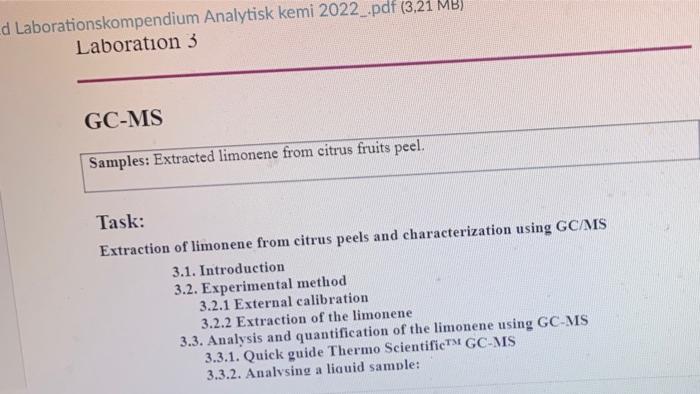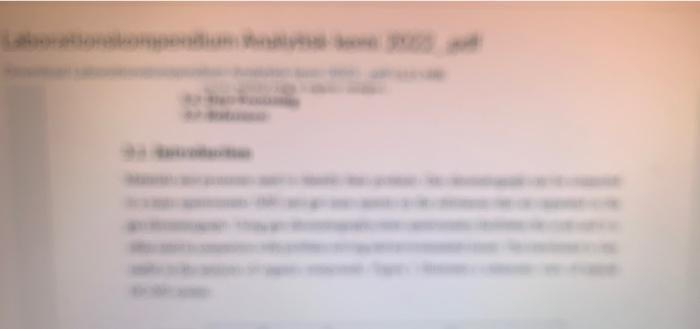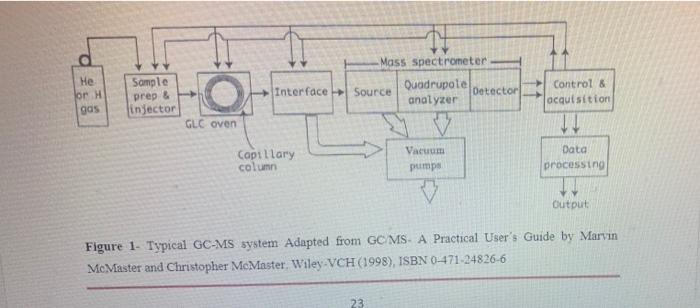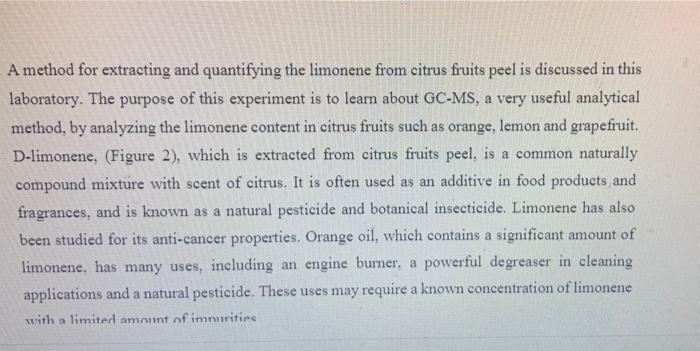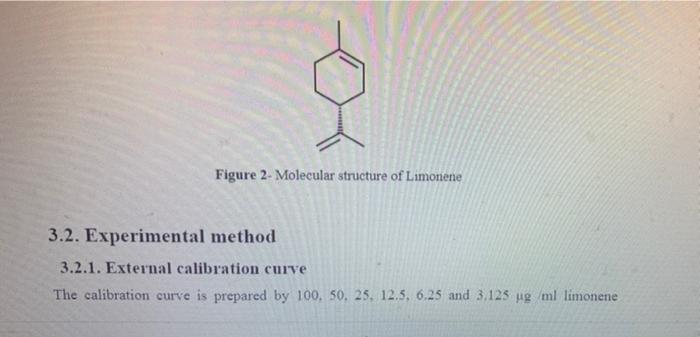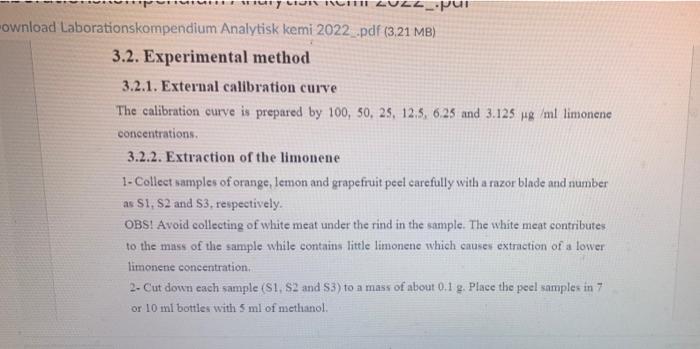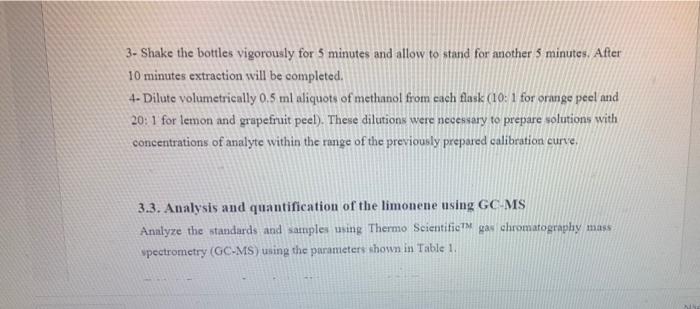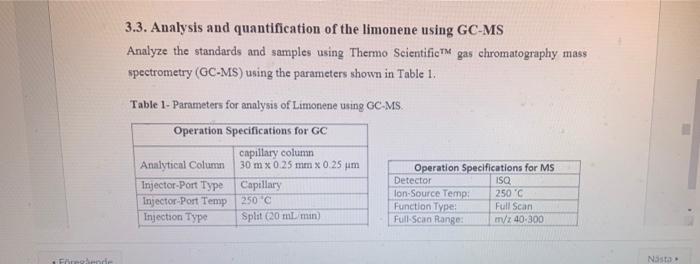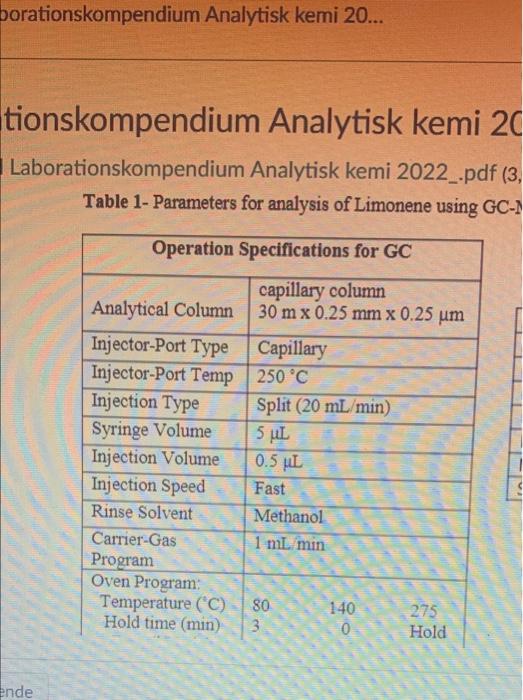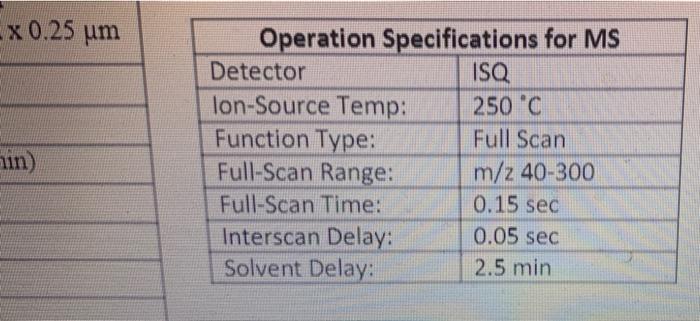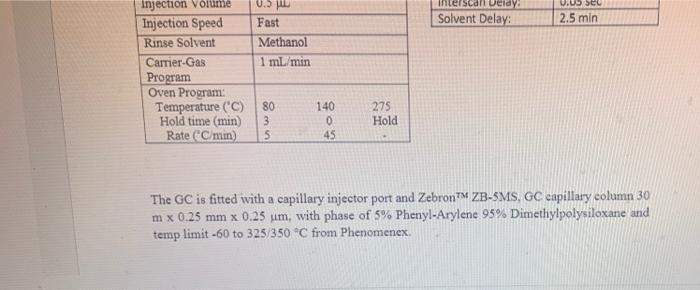d Laborationskompendium Analytisk kemi 2022_.pdf (3,21 MB) Laboration 3 GC-MIS Samples: Extracted limonene from citrus fruits peel. Task: Extraction of limonene from citrus peels and characterization using GC/MS 3.1. Introduction 3.2. Experimental method 3.2.1 External calibration 3.2.2 Extraction of the limonene 3.3. Analysis and quantification of the limonene using GC-MS 3.3.1. Quick guide Thermo Scientific I GC-MS 3.3.2. Analysing a liquid sample: JN JIJI muu mpe. 3.4. Data Processing 3.5. References 3.1. Introduction Materials and processes need to identify their products. Gas chromatograph can be connected to a mass spectrometer (MS) and get mass spectra on the substances that are separated in the gas chromatograph. Using gas chromatography-mass spectrometry facilitates the work and it is often used in connection with problem solving and environmental issues. The instrument is very useful in the analysis of organic compounds. Figure 1 illustrates a schematic view of typical GC-MS system He or H gos Sample prep injector ol Mass Spectrometer Interface Source Quadrupole Detector analyzer Control & acquisition GLC oven Capillary column Vacuum pumps Data processing Output Figure 1. Typical GC-MS system Adapted from GCMS. A Practical User's Guide by Marvin McMaster and Christopher McMaster Wiley-VCH (1998), ISBN 0-471-24826-6 23 A method for extracting and quantifying the limonene from citrus fruits peel is discussed in this laboratory. The purpose of this experiment is to learn about GC-MS, a very useful analytical method, by analyzing the limonene content in citrus fruits such as orange, lemon and grapefruit. D-limonene, (Figure 2), which is extracted from citrus fruits peel, is a common naturally compound mixture with scent of citrus. It is often used as an additive in food products and fragrances, and is known as a natural pesticide and botanical insecticide. Limonene has also been studied for its anti-cancer properties. Orange oil, which contains a significant amount of limonene, has many uses, including an engine burner, a powerful degreaser in cleaning applications and a natural pesticide. These uses may require a known concentration of limonene with a limited amount of immunities Figure 2. Molecular structure of Limonene 3.2. Experimental method 3.2.1. External calibration curve The calibration curve is prepared by 100, 50, 25. 12.5. 6.25 and 3.125 g ml limonene 17 pui ownload laborationskompendium Analytisk kemi 2022.pdf (3.21 MB) 3.2. Experimental method 3.2.1. External calibration curve The calibration curve is prepared by 100, 50, 25, 12.5, 6.25 and 3.125 HR ml limonene concentrations, 3.2.2. Extraction of the limonene 1- Collect samples of orange, lemon and grapefruit pcel carefully with a razor blade and number as S1, S2 and 53, respectively. OBS! Avoid collecting of white meat under the rind in the sample. The white meat contributes to the mass of the sample while contains little limonene which causes extraction of a lower limonene concentration 2- Cut down each sample (S1, S2 and 3) to a mass of about 0.1 g. Place the peel samples in 7 or 10 ml bottles with 5 ml of methanol. 3- Shake the bottles vigorously for 5 minutes and allow to stand for another 5 minutes. After 10 minutes extraction will be completed. 4- Dilute volumetrically 0.5 ml aliquots of methanol from each finsk (10: 1 for orange peel and 20: 1 for lemon and grapefruit peel). These dilutions were necessary to prepare solutions with concentrations of analyte within the range of the previously prepared calibration curve, 3.3. Analysis and quantification of the limonene using GC MS Analyze the standards and samples using Thermo Scientific gas chromatography mass spectrometry (GC-MS) using the parameters shown in Table 1 3.3. Analysis and quantification of the limonene using GC-MS Analyze the standards and samples using Thermo Scientific gas chromatography mass spectrometry (GC-MS) using the parameters shown in Table 1. Table 1- Parameters for analysis of Limonene using GC-MS. Operation Specifications for GC capillary column Analytical Column 30 mx 0.25 mm x 0.25 um Operation Specifications for MS Injector-Port Type Capillary Detector ISQ lon-Source Temp: 250C Injector-Port Temp 250C Function Type: Full Scan Injection Type Split (20 ml. min) Full-Scan Range: m/240-300 Fregende Na Download Laborationskompendium Analytisk kemi 2022_.pdf (3.21 MB) Table 1. Parameters for analysis of Limonene using GC-MS. Operation Specifications for GC capillary column Analytical Column 30 mx 0.25 mm x 0.25 um Operation Specifications for MS Injector-Port Type Capillary Detector 150 lon-Source Temp: 250C Injector-Port Temp 250 C Function Type Full Scan Injection Type Split (20 ml/min Full-Scan Range m/t 40-300 Syringe Volume 5 jul. Full-Scan Time: 0.15 sec Injection Volume 0.5 L Interscan Delay 0.05 sec Injection Speed Fast Solvent Delay 2.5 min Rinse Sohnt Methanol Camer-Gas Immun Program Oven Program Temperature (C) 80 140 275 Hold time) 3 Hold borationskompendium Analytisk kemi 20... tionskompendium Analytisk kemi 20 Laborationskompendium Analytisk kemi 2022_.pdf (3, Table 1- Parameters for analysis of Limonene using GC-1 Operation Specifications for GC capillary column Analytical Column 30 mx 0.25 mm x 0.25 um Injector-Port Type Capillary Injector-Port Temp 250 C Injection Type Split (20 mL/min) Syringe Volume 5 ul Injection Volume 0.5 L Injection Speed Fast Rinse Solvent Methanol Carrier-Gas 1 mL min Program Oven Program Temperature (C) 80 140 275 Hold time (min) 3 Hold 0 Ende x 0.25 um in) Operation Specifications for MS Detector ISQ lon-Source Temp: 250 C Function Type: Full Scan Full-Scan Range: m/2 40-300 Full-Scan Time: 0.15 sec Interscan Delay: 0.05 sec Solvent Delay: 2.5 min 0.05 sec Can weide Solvent Delay: 2.5 min Injection Volume 0.5 Injection Speed Fast Rinse Solvent Methanol Camer-Gas 1 mL/min Program Oven Program: Temperature (C) 80 140 Hold time (min) 3 0 Rate (C/min) S 45 275 Hold The GC is fitted with a capillary injector port and ZebronTM ZB-SMS, GC capillary column 30 mx 0.25 mm x 0.25 um, with phase of 5% Phenyl-Arylene 95% Dimethylpolysiloxane and temp limit -60 to 325/350 C from Phenomenex. Resultat och diskussion Ange det slutliga resultatet och ta upp mjliga felkllor. Nr du drar slutsatser, kom ihg att dessa ska formuleras, dvs diskutera varfr ett vist resultat erhllits. Det rcker inte med att enbart konstatera att det blivit p ett visst stt. d Laborationskompendium Analytisk kemi 2022_.pdf (3,21 MB) Laboration 3 GC-MIS Samples: Extracted limonene from citrus fruits peel. Task: Extraction of limonene from citrus peels and characterization using GC/MS 3.1. Introduction 3.2. Experimental method 3.2.1 External calibration 3.2.2 Extraction of the limonene 3.3. Analysis and quantification of the limonene using GC-MS 3.3.1. Quick guide Thermo Scientific I GC-MS 3.3.2. Analysing a liquid sample: JN JIJI muu mpe. 3.4. Data Processing 3.5. References 3.1. Introduction Materials and processes need to identify their products. Gas chromatograph can be connected to a mass spectrometer (MS) and get mass spectra on the substances that are separated in the gas chromatograph. Using gas chromatography-mass spectrometry facilitates the work and it is often used in connection with problem solving and environmental issues. The instrument is very useful in the analysis of organic compounds. Figure 1 illustrates a schematic view of typical GC-MS system He or H gos Sample prep injector ol Mass Spectrometer Interface Source Quadrupole Detector analyzer Control & acquisition GLC oven Capillary column Vacuum pumps Data processing Output Figure 1. Typical GC-MS system Adapted from GCMS. A Practical User's Guide by Marvin McMaster and Christopher McMaster Wiley-VCH (1998), ISBN 0-471-24826-6 23 A method for extracting and quantifying the limonene from citrus fruits peel is discussed in this laboratory. The purpose of this experiment is to learn about GC-MS, a very useful analytical method, by analyzing the limonene content in citrus fruits such as orange, lemon and grapefruit. D-limonene, (Figure 2), which is extracted from citrus fruits peel, is a common naturally compound mixture with scent of citrus. It is often used as an additive in food products and fragrances, and is known as a natural pesticide and botanical insecticide. Limonene has also been studied for its anti-cancer properties. Orange oil, which contains a significant amount of limonene, has many uses, including an engine burner, a powerful degreaser in cleaning applications and a natural pesticide. These uses may require a known concentration of limonene with a limited amount of immunities Figure 2. Molecular structure of Limonene 3.2. Experimental method 3.2.1. External calibration curve The calibration curve is prepared by 100, 50, 25. 12.5. 6.25 and 3.125 g ml limonene 17 pui ownload laborationskompendium Analytisk kemi 2022.pdf (3.21 MB) 3.2. Experimental method 3.2.1. External calibration curve The calibration curve is prepared by 100, 50, 25, 12.5, 6.25 and 3.125 HR ml limonene concentrations, 3.2.2. Extraction of the limonene 1- Collect samples of orange, lemon and grapefruit pcel carefully with a razor blade and number as S1, S2 and 53, respectively. OBS! Avoid collecting of white meat under the rind in the sample. The white meat contributes to the mass of the sample while contains little limonene which causes extraction of a lower limonene concentration 2- Cut down each sample (S1, S2 and 3) to a mass of about 0.1 g. Place the peel samples in 7 or 10 ml bottles with 5 ml of methanol. 3- Shake the bottles vigorously for 5 minutes and allow to stand for another 5 minutes. After 10 minutes extraction will be completed. 4- Dilute volumetrically 0.5 ml aliquots of methanol from each finsk (10: 1 for orange peel and 20: 1 for lemon and grapefruit peel). These dilutions were necessary to prepare solutions with concentrations of analyte within the range of the previously prepared calibration curve, 3.3. Analysis and quantification of the limonene using GC MS Analyze the standards and samples using Thermo Scientific gas chromatography mass spectrometry (GC-MS) using the parameters shown in Table 1 3.3. Analysis and quantification of the limonene using GC-MS Analyze the standards and samples using Thermo Scientific gas chromatography mass spectrometry (GC-MS) using the parameters shown in Table 1. Table 1- Parameters for analysis of Limonene using GC-MS. Operation Specifications for GC capillary column Analytical Column 30 mx 0.25 mm x 0.25 um Operation Specifications for MS Injector-Port Type Capillary Detector ISQ lon-Source Temp: 250C Injector-Port Temp 250C Function Type: Full Scan Injection Type Split (20 ml. min) Full-Scan Range: m/240-300 Fregende Na Download Laborationskompendium Analytisk kemi 2022_.pdf (3.21 MB) Table 1. Parameters for analysis of Limonene using GC-MS. Operation Specifications for GC capillary column Analytical Column 30 mx 0.25 mm x 0.25 um Operation Specifications for MS Injector-Port Type Capillary Detector 150 lon-Source Temp: 250C Injector-Port Temp 250 C Function Type Full Scan Injection Type Split (20 ml/min Full-Scan Range m/t 40-300 Syringe Volume 5 jul. Full-Scan Time: 0.15 sec Injection Volume 0.5 L Interscan Delay 0.05 sec Injection Speed Fast Solvent Delay 2.5 min Rinse Sohnt Methanol Camer-Gas Immun Program Oven Program Temperature (C) 80 140 275 Hold time) 3 Hold borationskompendium Analytisk kemi 20... tionskompendium Analytisk kemi 20 Laborationskompendium Analytisk kemi 2022_.pdf (3, Table 1- Parameters for analysis of Limonene using GC-1 Operation Specifications for GC capillary column Analytical Column 30 mx 0.25 mm x 0.25 um Injector-Port Type Capillary Injector-Port Temp 250 C Injection Type Split (20 mL/min) Syringe Volume 5 ul Injection Volume 0.5 L Injection Speed Fast Rinse Solvent Methanol Carrier-Gas 1 mL min Program Oven Program Temperature (C) 80 140 275 Hold time (min) 3 Hold 0 Ende x 0.25 um in) Operation Specifications for MS Detector ISQ lon-Source Temp: 250 C Function Type: Full Scan Full-Scan Range: m/2 40-300 Full-Scan Time: 0.15 sec Interscan Delay: 0.05 sec Solvent Delay: 2.5 min 0.05 sec Can weide Solvent Delay: 2.5 min Injection Volume 0.5 Injection Speed Fast Rinse Solvent Methanol Camer-Gas 1 mL/min Program Oven Program: Temperature (C) 80 140 Hold time (min) 3 0 Rate (C/min) S 45 275 Hold The GC is fitted with a capillary injector port and ZebronTM ZB-SMS, GC capillary column 30 mx 0.25 mm x 0.25 um, with phase of 5% Phenyl-Arylene 95% Dimethylpolysiloxane and temp limit -60 to 325/350 C from Phenomenex. Resultat och diskussion Ange det slutliga resultatet och ta upp mjliga felkllor. Nr du drar slutsatser, kom ihg att dessa ska formuleras, dvs diskutera varfr ett vist resultat erhllits. Det rcker inte med att enbart konstatera att det blivit p ett visst stt
